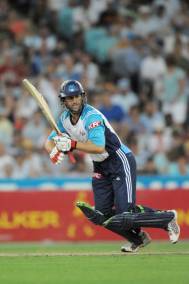Another Twenty20 Tournament – The Champions League
Martyn Corrin |
I used to think to myself, when I was a little younger, that it would be so cool if Lancashire could take on New South Wales or Queensland; or at least, the champions of England could take on the champions of Australia, in some form of international domestic cricket. Alas, I concluded, it could never happen, the seasonal differences caused by the hemispheres would make it impossible. What would happen to someone like Andrew Symonds, who played for both Lancashire and Queensland?!
Of course, what I didn’t anticipate, back then, was that the elite from each nation would get the chance stand up to one another whilst wearing their club colours. The timezone difficulties are eradicated by hosting the tournament on neutral grounds. The who-plays-for-who dilemma – well that’s easily solved, just let money talk and everything else will follow on naturally. Yes, as you may have noticed, the inaugural Champions League in cricket is about to get underway.
The title, ‘Champions League’, doesn’t exactly hide the intention of this tournament. It would be nice to think that it was to ensure the top players got to compete against each other on a regular basis – but let’s be honest, this is cricket in 2009, we’re hardly short on international competitions and series. No, this tournament is the latest chapter in Twenty20’s audacious effort to become the new football, or something similar, and by giving it the same name as football’s premier club competition, they have hardly been discreet about it. Whilst the IPL brought in internationals a plenty, this tournament will go one further, and we will see Cape Cobras take on Royal Challengers Bangalore, and other such contests. The I in IPL will always render it as domestic cricket, even if only in a completely technical sense, but an international domestic tournament like this is a brave new territory for cricket. It is worth noting that the first tournament was meant to happen last year, but the atrocities in Mumbai put paid to that. Whilst teams like Middlesex (who won the English Twenty20 Cup in 2008) will no doubt still feel somewhat bitter that their chance went without ever actually coming, there has been a lot more organisation and structure this time round, and if this tournament is a success, it will become a permanent fixture in the cricketing calendar; there is already talk of it getting its own window in the next Future Tours Programme.
So what can we expect in the next fifteen days? Well, there will be 23 Twenty20 matches (barring abandoments), with the tournament consisting of twelve teams, divided into four groups of three. The top three teams in the IPL qualified – the aforementioned Royal Challengers Bangalore, plus the champions, Deccan Chargers, and Delhi Daredevils. They will be joined by two teams from each of England, South Africa and Australia. These are Sussex, Somerset, Cape Cobras, Eagles, New South Wales and Victoria. On top of that, there is a side each from West Indies, New Zealand and Sri Lanka; Trinidad & Tobago, Otago and Wayamba. Sadly, Pakistan are not represented due to the political fallout to the events in Mumbai last December.
It is easy to be sceptical about this tournament, it is, after all, yet another Twenty20 tournament, coming roughly halfway between Twenty20 World Cups. It’s hard not to feel a little different about this one, though. Though some may consider it a contradiction in terms, for lovers of both cricket in general, and Twenty20, this upcoming contest presents us with a great opportunity. Yes, we all get to see the world’s top cricketers on a regular basis, with most teams playing each other regularly in bilateral series, plus a Twenty20 World Cup here and a Champions Trophy there. However, what cricket fans often don’t see as much of is the up and coming talent from other nations. An English cricket fan isn’t likely to have seen much of a young Australian prior to him making his Test debut, unless he happens to have played a fair bit of county cricket. Sure, it’s ‘only’ Twenty20, but it will be refreshing that in this tournament we get to check out youngsters like Richard Levi and Sybrand Engelbrecht of the Cape Cobras, as well as established internationals like Brendon McCullum (Otago) and Jacques Kallis (Royal Challengers Bangalore). On top of that, we have the likes of Adam Gilchrist (Deccan Chargers) and Marcus Trescothick (Somerset); retired from international cricket, but providing viewers around the world with the chance to enjoy their batting for a couple of weeks.
In theory you would expect the wealth of the IPL to ensure that the Indian squads are the strongest, but it is New South Wales which looks most impressive on paper. Theirs is a squad packed full of household names, in fact you wouldn’t bat an eyelid if it was named as the Australia squad – it features the likes of Simon Katich, Nathan Hauritz and Phillip Hughes, not to mention the express pace machine that is Brett Lee. That’s before we mention the likes of David Warner and Doug Bollinger, who are hardly nobodies, and Brad Haddin and Nathan Bracken both had to withdraw from the tournament!
The Indian sides are strong though, there is no getting away from that. The Deccan Chargers squad is particularly impressive, packed with a mixture of superstars and homegrown Indian talent. Adam Gilchrist will lead their campaign but he will be ably backed up by the likes of VVS Laxman, Andrew Symonds and Chaminda Vaas. The Royal Challengers also have a few big names in their squad but will be hurt by the withdrawal of New Zealand’s Jesse Ryder who sustained an injury to his left abductor muscle in the recent Champions Trophy. They will be led by Anil Kumble, and one to watch is explosive lower-middle order batsman Virat Kohli, he has already played a handful of one-day internationals for India and will be looking to improve on his performances in the IPL earlier in the year, where he scored quickly but did not sustain the runs for long enough. The Indian triumvirate is completed by Gautham Gambhir’s Delhi Daredevils; their side is probably the weakest of their compatriots, but it does include possibly the only man in the tournament who has a shot named after him, Tilakaratne Dilshan. They have been hit by withdrawals from Daniel Vettori, Paul Collingwood and AB De Villiers, but still boast a strong squad, also featuring internationals such as Virender Sehwag and Dinesh Karthik. A youngster to watch out for is left-arm seamer Pradeep Sangwan; he doesn’t come into the tournament with a huge pedigree, but in a squad not particularly heavy on seam-bowling (they had Glenn McGrath in the IPL but he won’t feature here), Sangwan will be eager to make a name for himself. He is not a fast bowler by any means, but he will not get flayed around too easily.
Outside of the Indian sides and New South Wales, we have Victoria, who are also a decent bet. They are captained by Cameron White who has showcased his limited overs skills on the international stage superbly in recent weeks. With a classical mixture of youth and experience, Victoria have a well-balanced squad and it features names you will have heard of, such as Peter Siddle and David Hussey. Their star batsman is Brad Hodge, many Victorians were seething when he was omitted from their squad for the World Cup earlier in the year and some believe him to be the finest Twenty20 batsman in the world. There are no real standout names outside of the internationals, one piece of trivia is that their squad includes James Pattinson, brother of Darren who represented England at Headingley in 2008 to mass national outrage. They are missing Dirk Nannes, who will represent Delhi Daredevils instead.
If this was a fifty-over tournament it would be difficult to see any side other than the five aforementioned ones lifting the trophy – but it isn’t, it’s Twenty20, and therefore none of the other sides should be ruled out either. The Cape Cobras may have lost out on Jacques Kallis, who is representing his IPL side instead, but they still have Jean-Paul Duminy and Herschelle Gibbs, although Graeme Smith misses out through injury. They are joined by their counterparts the Eagles who will be led by Boeta Dippenaar, but look out for a big tournament from bowling all-rounder Ryan McLaren who will be looking to join the international fold in the near future.
English representation comes from Sussex and Somerset. Sussex are not packed with household names – Luke Wright is probably their best known Englishman. They are a talented county side but should struggle to compete with the big names that the Australians, Indians and even the South Africans can field. Nonetheless, skipper Mike Yardy is no mug, useful with both bat and ball, especially in the shorter formats, you might remember him as one of the select few players England have used in one-day internationals in the 21st century, just like his team-mate Ed Joyce, who was hoping to play in this tournament last year after leading Middlesex to the title. You can also look out for all-rounder Piyush Chawla, who will seek a successful tournament to try and get himself back into the international fold. Somerset are similarly lacking in big names – that is except for two retired international openers, Justin Langer (the captain) and Marcus Trescothick, neither of whom should require any introduction. Their overseas player is South African seamer Charl Willoughby, his best days may be behind him but in Twenty20 terms he can keep the runs down on his day.
Otago have a relatively strong squad – they would back themselves to beat the English sides, you would imagine – it features both of the McCullums, Craig Cumming, Neil Broom, James McMillan and Aaron Redmond, as well as their overseas player, Dimitri Mascarenhas. They have players who can destroy attacks, you’d certainly imagine that their opponents won’t be taking them lightly. Similarly, Sri Lankan representatives Wyamba come with a mixture of internationals and, with all due respect, lesser-known players, their squad includes Jehan Mubarak, Mahela Jayawardene, Farveez Maharoof and enigmatic spinner Ajantha Mendis. The tournament is completed by the squad of Trinidad & Tobago; with players like Darren Ganga, Dwayne Bravo and Denesh Ramdin, it could be argued that it contains more ‘true’ West Indies internationals than the recent Champions Trophy side. They are probably the weakest side on paper, but just in case you missed it first time, this is Twenty20, and anything can happen.
Yes, there are reasons to be cynical about this tournament, given the amount of Twenty20 tournaments we are being fed. However, the winners get $2.5million prize money – if one of the non-IPL sides was to take the trophy, that money could make a real difference to that side, and as such it could potentially be a huge incentive to all domestic sides. Cynics and detractors can and will argue that that could be to the detriment of the first-class game, but it is hard to begrudge a side like Wyamba, Sussex or Otago the chance to earn such prize money. If this tournament gets even a few more people interested in their own domestic tournaments when their next season comes along, then it can be regarded as a success. Sit back and enjoy the next two weeks of cricket, by the way, my tip for the gold? I’m taking the easy route, New South Wales. Enjoy!





Leave a comment